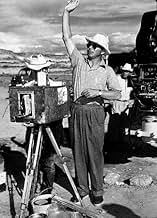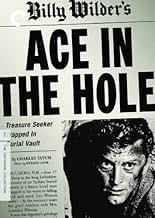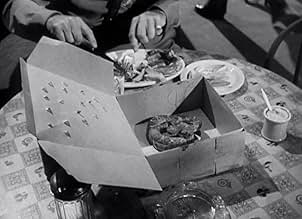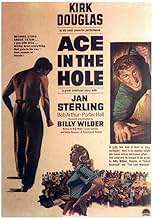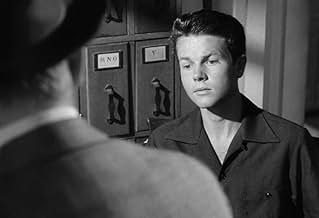VALUTAZIONE IMDb
8,1/10
41.137
LA TUA VALUTAZIONE
Un ex giornalista frustrato che ora lavora per un giornale di Albuquerque sfrutta la storia di un uomo intrappolato in una grotta per riaccendere la sua carriera, ma la situazione diventa ra... Leggi tuttoUn ex giornalista frustrato che ora lavora per un giornale di Albuquerque sfrutta la storia di un uomo intrappolato in una grotta per riaccendere la sua carriera, ma la situazione diventa rapidamente fuori controllo.Un ex giornalista frustrato che ora lavora per un giornale di Albuquerque sfrutta la storia di un uomo intrappolato in una grotta per riaccendere la sua carriera, ma la situazione diventa rapidamente fuori controllo.
- Regia
- Sceneggiatura
- Star
- Candidato a 1 Oscar
- 5 vittorie e 3 candidature totali
Robert Arthur
- Herbie Cook
- (as Bob Arthur)
Roy Regnier
- Nagel - New York Editor (replaced by Richard Gaines)
- (scene tagliate)
Oscar Belinda
- Barker
- (non citato nei titoli originali)
Recensioni in evidenza
10castolon
The movie very closely parallels the real events of January 30 to February 16, 1925 in terms of the general story line. There are some significant differences concerning the actions of the characters.
Floyd Collins, a cave explorer working alone (not a real good idea), was trapped in Sand Cave KY, near Mammoth Cave. He was not looking for treasure, but for a new cave suitable for commercializing to produce income in an economically depressed region...and this was before the Depression occurred.
He became trapped on the way out of the cave by a 27 lb. rock which rolled onto his leg in a narrow crawlway. The configuration was such that it could not be moved enough to get his foot past.
When he failed to return home, the family went searching and quickly found him only 150' inside the cave.
A huge rescue effort was mounted and a cub reporter, Skeets Miller, from Louisville KY showed up to cover the story. It became one of the three most widely broadcast events of the time. Besides the extensive newspaper coverage, the relatively new medium of commercial radio riveted listeners with hourly accounts. It quickly became the first media circus ever seen.
Because of the print and radio coverage people began flocking to the site. A carnival atmosphere did indeed spring up around the cave. The state police and National Guard were called out by the governor to control the chaos and the more than 20,000 onlookers. The similarity between the real event and the movie on this account are likely nearly identical.
As in the movie, a decision was made to drill a shaft and, also as in the movie, the rock was fairly unstable and prone to collapse from the pounding of the cable tool drilling rig. The longer the effort went on, the more unstable the cave passage became.
Unlike Kirk Douglas' character in the movie, Skeets Miller served a most honorable role. Due to his small build he became one of very few persons able, and eventually the only one willing, to enter in an attempt to deliver food and water to Collins. He received a Pulitzer Prize for his reporting. Also unlike the movie, there was no manipulation of the event to delay the rescue, but there was considerable disagreement over how to best do it. Area coal miners made the initial attempts and the event concluded with the above-mentioned shaft.
Collins was presumed to have died 3 days before rescuers reached him. Because the conditions were so unstable, the body was left in the cave. The family was able to remove him about 80 days afterward for a proper burial. Later, his glass-topped casket was returned to the now-commercial cave as a tourist attraction. It was removed once again, and finally, in 1989.
In 1982, a definitive account of the event was published in the book 'Trapped!'. A most informative read.
In a take-off of the 'Free Tibet' bumper stickers, vehicles are occasionally seen with a 'Free Floyd Collins' sticker.
Floyd Collins, a cave explorer working alone (not a real good idea), was trapped in Sand Cave KY, near Mammoth Cave. He was not looking for treasure, but for a new cave suitable for commercializing to produce income in an economically depressed region...and this was before the Depression occurred.
He became trapped on the way out of the cave by a 27 lb. rock which rolled onto his leg in a narrow crawlway. The configuration was such that it could not be moved enough to get his foot past.
When he failed to return home, the family went searching and quickly found him only 150' inside the cave.
A huge rescue effort was mounted and a cub reporter, Skeets Miller, from Louisville KY showed up to cover the story. It became one of the three most widely broadcast events of the time. Besides the extensive newspaper coverage, the relatively new medium of commercial radio riveted listeners with hourly accounts. It quickly became the first media circus ever seen.
Because of the print and radio coverage people began flocking to the site. A carnival atmosphere did indeed spring up around the cave. The state police and National Guard were called out by the governor to control the chaos and the more than 20,000 onlookers. The similarity between the real event and the movie on this account are likely nearly identical.
As in the movie, a decision was made to drill a shaft and, also as in the movie, the rock was fairly unstable and prone to collapse from the pounding of the cable tool drilling rig. The longer the effort went on, the more unstable the cave passage became.
Unlike Kirk Douglas' character in the movie, Skeets Miller served a most honorable role. Due to his small build he became one of very few persons able, and eventually the only one willing, to enter in an attempt to deliver food and water to Collins. He received a Pulitzer Prize for his reporting. Also unlike the movie, there was no manipulation of the event to delay the rescue, but there was considerable disagreement over how to best do it. Area coal miners made the initial attempts and the event concluded with the above-mentioned shaft.
Collins was presumed to have died 3 days before rescuers reached him. Because the conditions were so unstable, the body was left in the cave. The family was able to remove him about 80 days afterward for a proper burial. Later, his glass-topped casket was returned to the now-commercial cave as a tourist attraction. It was removed once again, and finally, in 1989.
In 1982, a definitive account of the event was published in the book 'Trapped!'. A most informative read.
In a take-off of the 'Free Tibet' bumper stickers, vehicles are occasionally seen with a 'Free Floyd Collins' sticker.
The cynical, unethical and unscrupulous journalist Charles 'Chuck' Tatum (Kirk Douglas) arrives in a small New Mexico newspaper asking for a chance. He was fired from famous newspapers because of drinking problem, lying and even for having an affair with the wife of one of his bosses. His real intention is to use the small newspaper as a "swimming board" to a bigger one. After one year without a bang news and totally bored, Chuck travels with a younger reporter to make the coverage of a matter about rattlesnakes. When they arrive in an isolated gas station, he is informed that a man called Leo Minosa (Richard Benedict) is trapped alive in an old Indian mine in a nearby place called Mountain of the Seven Vultures. Chuck manipulates the local corrupt sheriff, the engineer responsible for the rescue operation and Leo's wife Lorraine Minosa (Jan Sterling), and a rescue that could be made using a simple and common process in twelve hours, lasts six days using a sophisticated drilling system and creating a circus in the previously desert place. Everybody profits with the accident except the victim.
Movies about manipulation of people are usually excellent. I remember Costa-Gravas' "Mad City (1997), Barry Levinson's "Wag the Dog (1997)", Howard Hawks' "His Girl Friday (1940)", and even the recent real case of the chemical weapons. Yesterday I saw "Ace in the Hole" for the first time and I really was impressed how this film is amazingly real and updated. There are elements present in every modern society, such as: the powerful sheriff very corrupt, like most of the worldwide members of the governments; the press, interested in selling news only; the victim used for other interests greater than rescuing him; and the people, completely manipulated and with very short memory. Kirk Douglas is amazing in the role of a nasty reporter. I do not understand why this movie is not in the IMDb Top 250. My vote is ten.
Title (Brazil): "A Montanha dos Sete Abutres" ("The Mountain of the Seven Vultures")
Movies about manipulation of people are usually excellent. I remember Costa-Gravas' "Mad City (1997), Barry Levinson's "Wag the Dog (1997)", Howard Hawks' "His Girl Friday (1940)", and even the recent real case of the chemical weapons. Yesterday I saw "Ace in the Hole" for the first time and I really was impressed how this film is amazingly real and updated. There are elements present in every modern society, such as: the powerful sheriff very corrupt, like most of the worldwide members of the governments; the press, interested in selling news only; the victim used for other interests greater than rescuing him; and the people, completely manipulated and with very short memory. Kirk Douglas is amazing in the role of a nasty reporter. I do not understand why this movie is not in the IMDb Top 250. My vote is ten.
Title (Brazil): "A Montanha dos Sete Abutres" ("The Mountain of the Seven Vultures")
There are some films that when you see them you ask why they aren't available to rent or own. This is one of them. I had the fortune of seeing this hidden gem on the big screen and was pleasantly surprised.
With Kirk Douglas playing a Reporter whose been around the block, always looking for a shortcut, comes across an opportunity to exploit a man caught in a mine shaft. I have read where critics had considered the circus atmosphere of the the film unrealistic. It seems Mr. Wilder got the last laugh. If you are interesting in great dialogue and good story telling, I suggest you find this
With Kirk Douglas playing a Reporter whose been around the block, always looking for a shortcut, comes across an opportunity to exploit a man caught in a mine shaft. I have read where critics had considered the circus atmosphere of the the film unrealistic. It seems Mr. Wilder got the last laugh. If you are interesting in great dialogue and good story telling, I suggest you find this
Saw this films years ago and it's still gripping.Mr.Wilder seldom did films that gripped the human condition like this one.After this movie flopped he stuck to screen adaptions of stage hits through most of the fifties.Both director and star,Kirk Douglas really delivered a stinging expose of media hype and manipulation of the newspaper business.Herein,burned out reporter Douglas chances on a man trapped in a cave and ruthlessly exploits it for his own gain.There's no softness here,even the leading lady (played wonderfully by Jan Sterling)is as hard as Douglas.The scenes of all the gawkers showing up,complete with carnival,are outright creepy.There's even a cheesy country western singer plunking a guitar and singing about poor Leo,(the trapped man.) The only sympathetic person is poor Leo's mom who continually prays for his release.Definitely a film for lovers of great movie drama.
Of the many movies I viewed in the early 50's, so many ,like now, were here today, forgotten tomorrow. However some movies that became memorable and that were able to make a dramatic impact on this young guy include, Duel in the Sun and Gone with the Wind. Strangely enough, Ace in the Hole is the most memorable of all movies viewed. It is one that invades the mind and leaves one sad.
Few films I remember as vividly as this dark movie, the images linger to haunt me still. 'Why?' one might ask 'would a sombre movie like this made over 50 years ago remain so memorable, when so many others have vanished. Was it the surreal inhumanity of the plot, the repugnant newsman devoid of ethics, the exploitation of the trapped victim, the purposeful prolonging of the victim's entrapment to create a media frenzy, the ultimate commercial creation of an 'event' style attraction complete with a circus like atmosphere surrounding the cave while the victim remained entrapped and close to death.'
Supposedly based on a real incident, it's a tough movie to watch and more so if one is prepared to accept the premise that such inhumanity displayed in the movie has an element of truth.
I echo the desires of others to have the availability of this movie on VHS or DVD. In the interim my memory will continue to keep the images intact. See it if you can.
Few films I remember as vividly as this dark movie, the images linger to haunt me still. 'Why?' one might ask 'would a sombre movie like this made over 50 years ago remain so memorable, when so many others have vanished. Was it the surreal inhumanity of the plot, the repugnant newsman devoid of ethics, the exploitation of the trapped victim, the purposeful prolonging of the victim's entrapment to create a media frenzy, the ultimate commercial creation of an 'event' style attraction complete with a circus like atmosphere surrounding the cave while the victim remained entrapped and close to death.'
Supposedly based on a real incident, it's a tough movie to watch and more so if one is prepared to accept the premise that such inhumanity displayed in the movie has an element of truth.
I echo the desires of others to have the availability of this movie on VHS or DVD. In the interim my memory will continue to keep the images intact. See it if you can.
Lo sapevi?
- QuizAfter the film was released, it got bad reviews and lost money. The studio, without Billy Wilder's permission, changed the title to "The Big Carnival" to increase the box office take of the film. It didn't work. On top of that, Wilder's next picture, Stalag 17 (1953), was a hit and he expected a share of the picture's profits. Paramount's accountants told him that since this picture lost money, the money it lost would be subtracted from the profits of "Stalag 17".
- BlooperWhen Lorraine and Chuck are talking out in front of Minosa's store by the gas pumps, reflections of the crew moving around behind the camera can be seen in the store windows.
- Citazioni
Charles Tatum: Bad news sells best. Cause good news is no news.
- ConnessioniFeatured in AFI Life Achievement Award: A Tribute to Billy Wilder (1986)
- Colonne sonoreThe Hut-Sut Song
(uncredited)
Written by Leo Killion, Ted McMichael and Jack Owens
Sung by Richard Benedict and Kirk Douglas
I più visti
Accedi per valutare e creare un elenco di titoli salvati per ottenere consigli personalizzati
Dettagli
Botteghino
- Budget
- 1.800.000 USD (previsto)
- Lordo in tutto il mondo
- 2.300.087 USD
- Tempo di esecuzione1 ora 51 minuti
- Colore
- Proporzioni
- 1.37 : 1
Contribuisci a questa pagina
Suggerisci una modifica o aggiungi i contenuti mancanti


